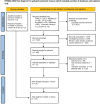Evidence-based evaluation of adjuvant therapy with Chinese medicine for cerebral small vessel disease: A systematic review and meta-analysis
- PMID: 38206688
- PMCID: PMC10754558
- DOI: 10.1097/MD.0000000000036221
Evidence-based evaluation of adjuvant therapy with Chinese medicine for cerebral small vessel disease: A systematic review and meta-analysis
Abstract
Background: As the population ages, the prevalence of cerebral small vessel disease (CSVD) steadily increases, resulting in a significant economic burden on society. In East Asian nations, Chinese medicine has been used extensively to teat CSVD and has been reported to improve the cognitive function of patients. The present study aimed to comprehensively assess the efficacy and safety of Chinese medicine as adjuvant therapy for CSVD.
Methods: A literature search of the CNKI, Wanfang, VIP, SinoMed, Medline, Cochrane Library, and ChiCTR databases were searched for RCTs investigating the use of TCM as an adjuvant in the treatment of CSVD, published up to July 27, 2023, was performed. Based on the Cochrane Collaboration Network bias risk assessment criteria, Review Manager version 5.3 was used to perform a meta-analysis.
Results: Meta-analysis of 27 RCTs, including 2554 subjects, revealed that the majority of the RCTs exhibited risk for ambiguous bias. The findings demonstrated that the use of Chinese medicine as an adjuvant treatment for CSVD effectively enhanced the cognitive function, as evidenced by improvements in the MMSE score (mean difference (MD) = 2.42, 95% confidence interval (CI) [1.79,3.17], P < .00001), MoCA score (MD = 2.39, 95% CI [1.78,2.99], P < .00001) and ADL score (MD = 4.13, 95% CI [1.74,6.51], P = .0007). Furthermore, the study also demonstrated the advantages of Chinese medicine adjuvant therapy in enhancing the Chinese medicine syndrome score (MD = -2.57, 95% CI [-3.31, -1.83], P < .00001), CRP (MD = -1.35, 95% CI [-2.27, -0.43], P = .004), Hcy (MD = -3.44,95% CI [-4.05, -2.83], P < .00001), and blood flow velocity (CBV) (MD = 1.37,95% CI [0.24,2.50], P = .02). Moreover, there was no statistical difference in the incidence of adverse reactions between the 2 groups.
Conclusion: Findings of the present study indicate that the Chinese medicine, as an adjuvant to conventional treatment, appeared to be efficacious in enhancing cognitive function, reducing Chinese medicine syndrome score, improving blood biochemical markers, and improving cerebral blood flow perfusion in patients with CSVD, without any notable adverse reactions. However, it is imperative to validate these conclusions in future high-quality investigations.
Copyright © 2023 the Author(s). Published by Wolters Kluwer Health, Inc.
Conflict of interest statement
The authors have no funding and conflicts of interest to disclose.
Figures











Similar articles
-
Chinese herbal medicine for vascular cognitive impairment in cerebral small vessel disease: A protocol for systematic review and meta-analysis of randomized controlled trials.Medicine (Baltimore). 2020 Oct 2;99(40):e22455. doi: 10.1097/MD.0000000000022455. Medicine (Baltimore). 2020. PMID: 33019432 Free PMC article.
-
[Network Meta-analysis of Chinese medicine injection for cerebral small vessel disease].Zhongguo Zhong Yao Za Zhi. 2025 May;50(9):2563-2581. doi: 10.19540/j.cnki.cjcmm.20250217.501. Zhongguo Zhong Yao Za Zhi. 2025. PMID: 40461210 Chinese.
-
Efficacy and safety of the integration of traditional Chinese medicine and western medicine in the treatment of diabetes-associated cognitive decline: a systematic review and meta-analysis.Front Pharmacol. 2023 Nov 22;14:1280736. doi: 10.3389/fphar.2023.1280736. eCollection 2023. Front Pharmacol. 2023. PMID: 38074157 Free PMC article. Review.
-
A systematic review and meta-analysis of the efficacy and safety of traditional Chinese medicine in the treatment of rhinosinusitis.Medicine (Baltimore). 2024 Nov 29;103(48):e40192. doi: 10.1097/MD.0000000000040192. Medicine (Baltimore). 2024. PMID: 39612467 Free PMC article.
-
Efficacy and safety of traditional Chinese medicine adjuvant therapy for severe pneumonia: evidence mapping of the randomized controlled trials, systematic reviews, and meta-analyses.Front Pharmacol. 2023 Sep 29;14:1227436. doi: 10.3389/fphar.2023.1227436. eCollection 2023. Front Pharmacol. 2023. PMID: 37841930 Free PMC article.
References
-
- Pantoni L. Cerebral small vessel disease: from pathogenesis and clinical characteristics to therapeutic challenges. Lancet Neurol. 2010;9:689–701. - PubMed
-
- Wardlaw J, Smith C, Dichgans M. Small vessel disease: mechanisms and clinical implications. Lancet Neurol. 2019;18:684–96. - PubMed
-
- Camarda C, Torelli P, Pipia C, et al. . Association between atrophy of the caudate nuclei, global brain atrophy, cerebral small vessel disease and mild parkinsonian signs in neurologically and cognitively healthy subjects aged 45-84 years: a crosssectional study. Curr Alzheimer Res. 2018;15:1013–26. - PubMed
Publication types
MeSH terms
LinkOut - more resources
Full Text Sources
Research Materials
Miscellaneous

